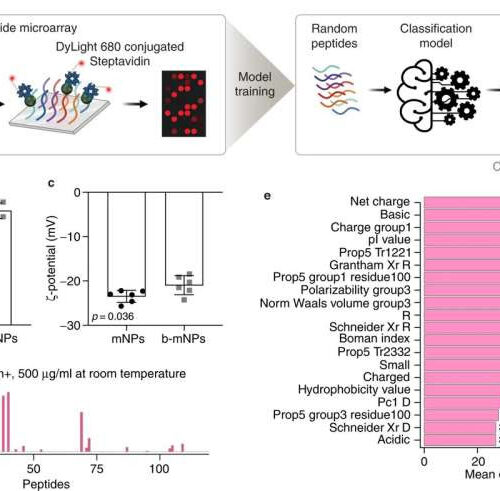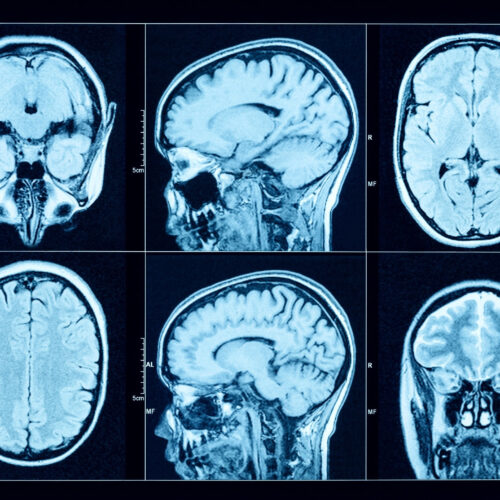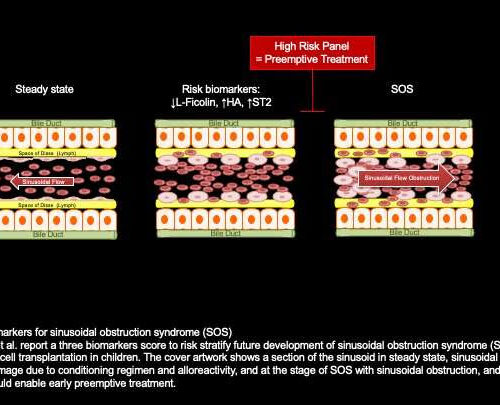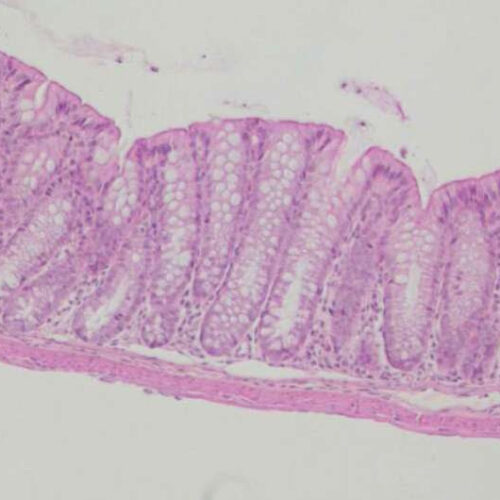by Nancy Fliesler, Children’s Hospital Boston Graphical abstract. Credit: Developmental Cell (2023). DOI: 10.1016/j.devcel.2023.04.007 Our bodies make blood in a specialized niche—a “nursery” within our bone marrow that nurtures blood stem cells so they can replicate and make different kinds of blood cells. The lab of Leonard Zon, MD, has even shown how blood stem cells, once they...
AI used to advance drug delivery system for glaucoma and other chronic diseases
by Johns Hopkins University School of Medicine Pilot 119 melanin binding peptide microarray screening with machine learning analysis. a Schematic illustration of the first peptide microarray. Peptides were anchored to a microarray, and melanin nanoparticles (mNPs) with surface biotinylation (b-mNPs) were flowed over to characterize binding events. The fluorescence intensity of the biotin was detected using DyLight 680-conjugated...
Gout unveiled as surprising culprit in neurodegenerative diseases
By Bhavana Kunkalikar May 22 2023 Reviewed by Benedette Cuffari, M.Sc. In a recent study published in the journal Nature Communications, researchers explore the relationship between gout and neurodegenerative disease susceptibility. Study: Association of gout with brain reserve and vulnerability to neurodegenerative disease. Image Credit: Triff / Shutterstock.com What is gout? Gout, which is often referred to as hyperuricemia, is...
Researchers create antimicrobial ‘superfoam’
A versatile new antimicrobial foam material developed by researchers at the University of Georgia could significantly reduce healthcare-related infections caused by implanted medical devices—or drastically improve cleanup efforts following environmental disasters like oil spills. Like a spongy Swiss Army knife, the porous three-dimensional foam is water repellent—meaning it resists blood, microbes and proteins, while also exhibiting antimicrobial and...
Cell Culture Chamber Mimics Mechanical States of Disease
MAY 23RD, 2023 CONN HASTINGS CARDIOLOGY, MEDICINE, PATHOLOGY Researchers at the University of Göttingen in Germany have developed a cell culture chamber that lets them culture tissue samples, mimic the mechanical conditions that tissues experience in various disease states, and closely monitor tissue reactions. The technology could be particularly useful for pre-clinical drug testing, allowing researchers to test the...
Supposedly rare diseases aren’t as rare as previously thought
UNIVERSITY OF BASEL Rare diseases are often caused by defects in genetic material. If children inherit only a defective gene from one parent, they often are asymptomatic “carriers” – or at least that was the previous assumption. However, a research team from the University of Basel and the University Hospital Basel is now reporting that...
NUS study: Brief weekly magnetic muscle therapy improves mobility and lean body mass in older adults
NATIONAL UNIVERSITY OF SINGAPORE IMAGE: ASSOCIATE PROFESSOR ALFREDO FRANCO-OBREGÓN (STANDING, RIGHT), PRINCIPAL INVESTIGATOR AT NUS INSTITUTE FOR HEALTH INNOVATION & TECHNOLOGY, AND MS SHARANYA VENUGOBAL (STANDING, LEFT), CLINICAL RESEARCH COORDINATOR AT QUANTUMTX, WITH 79-YEAR-OLD BIXEPS USER MR GEORGE TEO. CREDIT: NATIONAL UNIVERSITY OF SINGAPORE A decline in functional mobility, loss of muscle strength and an...
Risk biomarkers could predict serious side effect of stem cell transplant
by Leslie Cantu, Medical University of South Carolina This shows a section of the sinusoid in steady state, sinusoidal narrowing after endothelial damage due to conditioning regiment and alloreactivity, and at the stage of SOS with sinusoidal obstruction. Credit: Sophie Paczesny Doctors are one step closer to having a risk biomarker to alert them to which...
Adverse pregnancy outcomes increase stroke risk
by Cedars-Sinai Medical Center Credit: Pixabay/CC0 Public Domain Investigators from the Smidt Heart Institute at Cedars-Sinai found that women who experience an adverse pregnancy outcome—such as gestational hypertension, preeclampsia or preterm birth—have a higher risk of developing stroke in their lifetime, and at a younger age. The findings, published today in the peer-reviewed journal Stroke, also found...
Protein complex mediates protection against intestinal autoinflammation
by Weizmann Institute of Science Twelve days after injury, the lining of the colon was much more inflamed in mice lacking the NLRP10 inflammasome in their intestinal epithelial cells (bottom) than in the controls (top). Credit: Weizmann Institute of Science A new study by Prof. Eran Elinav’s lab at the Weizmann Institute of Science got an...








